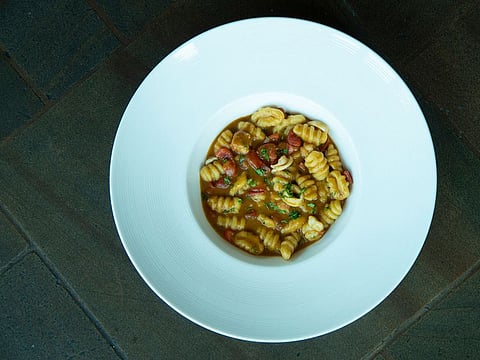How to make 'Cavatelli al Sugo di Mare' or shell pasta in seafood bisque from scratch
Italian chef offers a step-by-step guide to making pasta at home without a machine

He was right, I think, as I slurp on the tomato-flavoured sauce that’s glistening on the cavatelli on my plate. We’ve just finished class and are enjoying the results of our labour. The pasta named for the way it’s been made – with ‘little hollows’ in the centre – has become a storehouse for the bisque; a rich, creamy soup made of seafood broth, carrot and fresh tomato. Each bite brings that tart, sweet flavour profile to the tongue.
Chef Alberto Burgio, who hails from Italy, explains at the start of the masterclass at Trattoria that this type of pasta isn’t one that will spoil easily – it’s made using flour and semolina that will soak up the goodness but is devoid of egg protein that would have caused a rotting. He recalls a time when COVID-19 restrictions meant he was stuck at home last year. “I made so many of this type of pasta – I stopped buying,” he laughs.
Cavatelli is common in Southern Italy – especially Molise, Puglia, Campania, Basilicata, Calabria and Sicily, where Chef Burgio is from.
As he takes us through the process of dough making, he offers tips on kneading dough: press with your palm, close in half, then rotate the dough counter clockwise 90 degrees and repeat.
This is a simple pasta; with only two types of flour, oil and water, the variables are limited and so are the chances to get it wrong. However, Murphy’s Law – whatever can go wrong will – is still in play. So pay attention to this next tip. Chef Burgio explains: “[If you don’t] wrap it properly [this would be] the biggest mistake, because if this pasta gets dry while it rests, it’s difficult to work on it with the thumb, because then the thumb has no grip on the pasta.”
Other types of pastas can be a bit more complicated. “The recipe is always changed based on the shape of the pasta,” he says. “The main thing we need to consider about pasta dough is there are different ingredients to use and every ingredient has different characteristics. The two characteristics we need in the dough is elasticity – to be stretchy – and to be hard enough to be cooked al dente, or firm to the bite.
“Semolina and yolk are those ingredients that give it hardness to make it al dente and white of the egg and 00 flour that give it elasticity.”
If any of these ingredients is used too generously – or frugally – the shape and state of the pasta will be affected. And then there’s the resting phase. “Always rest the pasta dough for at least 30 minutes in the chiller. It’s not good to work on the pasta, to cook it right after mixing it. Because the flour, the gluten… there are many things, many substances inside the dough that need time to tie together.”
I recall my own clumsy attempts at making pasta sheets and how they tore as they passed through a manual machine. Chef Burgio explains that two things may have happened at this time – I got the proportions wrong, making the dough too dry resulting in less elasticity and so less resistance in the dough. “Sometimes the pasta machine is dirty, so it will break,” he adds, quietly, trying to not be judgemental about it.
Perhaps I’ll stick to the cavatelli, a gnocchi-looking pasta with a pouch for the best bit – the delicious sauce.
Recipe: Cavatelli al Sugo di Mare
Ingredients
For Cavatelli dough
For Sugo di mare
Method
For Cavatelli dough
1. Mix the two flours, make a hole in the middle and slowly pour the water while mixing.
2. Next add in the oil and knead until the dough is homogenously mixed and smooth.
3. Wrap the dough in plastic to seal in the moisture and let it rest for an hour in the chiller.
4. Cut the dough into tiny balls.
5. Roll the ball off the back of a fork using your thumb to create a dent in the pasta, which will also have a gnocchi-like design thanks to the cutlery.
For Sugo di mare
1. In a large pot, roast the prawn heads in half the butter, breaking and squeezing them with a wooden spoon to ensure you extract all the juice. They will turn brown, which means they are well roasted.
3. Add ice cubes and leave the pot on a low flame.
4. After an hour of cooking, strain the heads from the broth and keep the liquid aside.
5. In another pan, saute the carrots with the other half of the butter until they turn golden-brown.
6. Cook the broth and carrots together for an hour. Cool and blend into a bisque.
To finish the dish
1. In a pot with boiling water, add a pinch of salt. Cook Cavatelli for about three minutes until it’s al dente.
2. Preheat the bisque and add the pasta along with your favourite seafood.
3. Cook together with fresh tomato and season with basil, salt and black pepper. Serve hot.
Sign up for the Daily Briefing
Get the latest news and updates straight to your inbox









